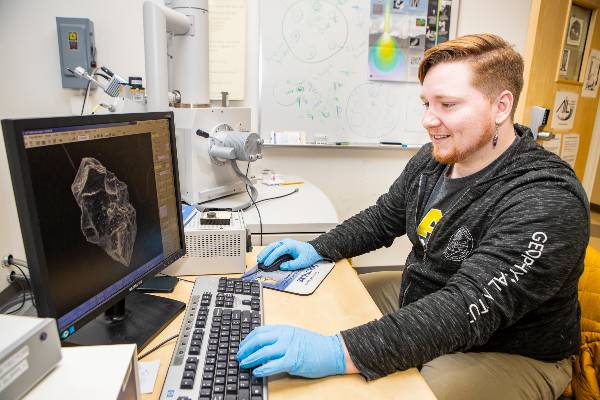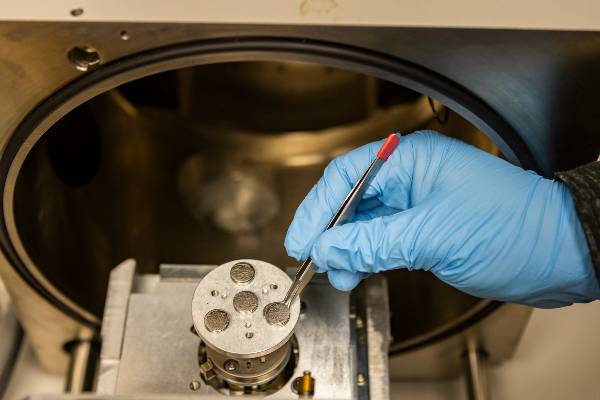David Harvey

Even as a child growing up on the Pacific coast, David Harvey wanted to be a volcanologist.
A chance meeting with UAF faculty members at the annual Whalefest in Sitka, Alaska, brought Harvey north in fall 2019 from Washington state, where he had attended community college. Now, as a geophysics undergraduate, he studies volcanic ash at the Advanced Instrumentation Laboratory in the Reichardt Building.
During a visit to the lab in February 2020, Harvey pointed to the image of an ash particle on a computer screen connected to a scanning electron microscope.
The particle, filling the screen, was in reality just a speck of dust. Harvey was trying to detect the elements within the particle, with the eventual goal of studying their health effects.
“When you shoot something with a bunch of electrons, magic physics happens and it bounces some X-rays back at you. Each element (in an ash particle) will send back an X-ray that has a certain energy level, and it’s always the same no matter what,” he explained.
“So this one has silicon and calcium and iron,” he said, pointing to the particle on the screen. “Then I have a handy-dandy little book that somebody who’s much smarter than me wrote that I can compare with and be like ‘Oh, it must be this mineral.’”
Harvey’s path to this place didn’t followed a traditional line or schedule, so he’s a bit older than the average undergraduate. At 13, following a move from Oregon to Alabama, he had to leave his family home. He stayed with another family until he was 17 but then left and dropped out of high school. He got a GED and moved back to Oregon, where he attended Lane Community College.

“I couldn’t get an apartment on my own. It was a whole crazy time,” he said. He started working seasonally for national park concessionaires around the western U.S. That’s where he met his partner, and they eventually decided to go back to college, this time in Washington.
After the chance meeting with UAF faculty members in Sitka, Harvey and his partner moved north. They both got scholarships from the UAF Biomedical Learning and Student Training program. It funds Harvey’s volcanic ash research.
“It’s hard not to be inspired by volcanoes when you grow up near Mount St. Helens (which erupted violently 1980),” he said. “I was determined at like 4 or 5 that I wanted to be a volcanologist. I had a really long twisty path to get where I am now, but I’m well on my way to doing that.”
The opportunities at UAF and the respect he receives from faculty members have surprised him, he said.
“I didn’t think I’d be able to use a scanning electron microscope as an undergraduate student, but they gave me the password to this door and let me come in whenever I want,” he said. “I’m pretty sure this thing is very, very expensive. More zeros behind the numbers than I know.” One other thing about Fairbanks surprised him. “All the Thai food in Fairbanks — what is that about?” he asked. “And each one has something that they do very well compared to the other ones.”
